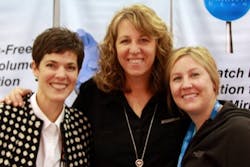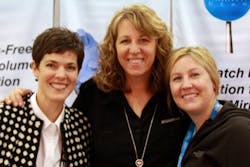Online continuing education
It’s not exactly a computer manual, but there are some things you should know
by Ann-Marie DePalma, CDA, RDH, MEd, FAADH
Over the last five to 10 years, formal higher education has shifted from “brick and mortar” schools to online learning and blended learning experiences (combination online and traditional classroom). In fact, when I was researching programs for my master’s degree several years ago, the one caveat I had was that a program needed to be online to suit my life situation. The program I chose was a blended experience, one where most of the program was online and only a few courses were actually presented in the traditional classroom format. For me, since the campus was local, it meant a couple of semesters on campus during the evenings, but for others who were scattered across the country, intensive summer programs on Nantucket Island were perfect for them.
Recently, I attended a conference where one of the presenters focused on the need for general higher education to embrace the blended learning experience now more than ever in light of the Obama push for higher education for more Americans. But what does that mean for us as dental professionals? Yes, we still will require our traditional educational experience to gain entry-level skills, but what happens after we graduate and need to pursue continuing-education credits and ongoing educational experiences? Are online or blended continuing-education courses the answer?
As a continuing-education presenter, I often see participants in programs attending because “they only need the credits.” If opportunities existed for those to receive a portion of their CE online, would these individuals feel any different in an online experience vs. a live experience? Many states currently allow a portion of continuing education to be achieved via home study, reading, or online education. However, most CE credits must still be obtained via live, in-person presentations. Given the nature of clinical practice, this should continue. But many types of programs and courses can be just as engaging online as they are in person, and sometimes even more since the participant must actively participate in the online educational experience. There is a benefit and need for both in-person and online experiences.
Synchronous or asynchronous
Online education can be synchronous or asynchronous. Synchronous education occurs when all participants enter the program at the same time and can participate with real-time chat and video/audio conferencing. Some programs allow for interaction as the program is ongoing, while in others only the presenter can control the course and participate. With asynchronous programs, the presentation is recorded and the participants can participate anytime and anywhere — not just when the program is being presented, but for a period of time after the recording. Asynchronous programs do not allow for any interaction between presenter and participants. There are several types of programs that are available for both synchronous and asynchronous learning. Webinars are Web conferences and are a type of synchronous learning, while podcasts are a series of media files (either audio or video) that are released episodically and are usually asynchronous.
Many corporations are producing asynchronous programs for continuing education to promote products, procedures, or policies. These programs can be video, audio, or combination programs and can be accessed at any time. At my present position, we are required to do a number of programs online for the company’s policies and procedures, as well as to enhance our job performance. Each has a certificate of completion and may require a post-test to ensure sufficient knowledge has been obtained.
I was privileged a few years ago to work with a dental industry leader to develop a program for the company’s Web site to provide continuing education for dental professionals. The program involved an asynchronous presentation with follow-up questions to test knowledge. For nonlive continuing education to be valid — whether online or in-print — the provider must prove that the participant has achieved the program’s goals and objectives. In-person live programs, depending on the particular program, often do not have this requirement.
Hygienists I have spoken with in regard to online continuing-education programs have stated that they prefer live events; however, they understand that there are times when attending a live event is not feasible. Some areas of the country do not have access to regularly scheduled continuing-education events, so attending an online program is beneficial. With today’s economy, free or inexpensive continuing-education programs are important for dental professionals. Travel is expensive and many hygienists have family or work commitments that dictate when and where courses can be taken. However, many love the interaction with other professionals at live meetings, reconnecting with friends and enjoying downtime.
From a presenter’s point of view, online continuing-education programs present unique challenges. A presenter often judges how a program is going by judging the body language of attendees and interaction with the audience. Online programs do not allow for this interaction. Additionally, technology is great, but with online programs, many things can go wrong, from computer glitches to Internet accessibility. Online programs often are shorter than live programs; therefore, the presenter must condense information into precise direct information, which leaves little room for any extra materials. During my master’s program, we had a course specifically on the demands and requirements for education delivered via online vs. traditional educational methods.
CE offered through companies
Many dental corporations now have a variety of continuing-education programs available. PennWell Corporation/RDH Magazine has taken this a step further. RDH Event is an online continuing-education program that offers the best of live CE without the expense of travel. The program is offered twice a year, in the spring and fall, and offers exhibitors, CE courses, and networking opportunities over the course of two days. There are exhibit booths where companies have representatives present with whom participants can chat in real time, a lounge area where networking opportunities abound, and continuing education provided both synchronously and asynchronously. There are even opportunities to win great prizes!
Previous RDH Event participants have made these comments:
- The online conference is perfect for my busy schedule.
- I loved the keynote speaker and the ability to speak with vendors about products.
- I enjoyed being able to communicate with other clinicians from the comfort of my home.
- I liked the on-demand ability of the conference where I could attend sessions before or after work or at lunch.
- It’s free CE.
PennWell also offers programs such as Webcasts and virtual trade shows.
Additionally, PennWell, in conduction with the Academy of Dental Therapeutics and Stomatology, has developed online, asynchronous, self-study, continuing-education programs for dental professionals. Topics cover all aspects of dentistry and dental hygiene and can be viewed at www.IneedCE.com. Many of the nation’s most respected and knowledgeable clinicians are the instructors.
Continuing education is a necessity
Continuing education is a necessity for dental professionals. The variety of opportunities that are available are multiplying by leaps and bounds with the availability of online educational experiences. However, we must be diligent consumers of these programs just as we are with live programs. There are exceptional programs and not-so-wonderful programs. Endorsements by corporations must be divulged, and participants must be discriminating in their choices. However, the availability of these programs offers the dental hygienist the ability to enhance his or her knowledge in many areas of dental hygiene that may not have been previously tapped.
Ann-Marie C. DePalma, RDH, MEd, FAADH, is a fellow of the American Academy of Dental Hygiene and a member of ADHA and other professional associations. Ann-Marie presents continuing-education programs for hygienists and dental team members and has written numerous articles on a variety of topics. She can be reached at [email protected].
Pros and cons of online CE
Many hygienists are unfamiliar with online continuing education. For those who have never participated in a program, here are a few pros and cons about the process.
Pros of online continuing education:- Can be free or less expensive than in-person education events with no travel involved
- Can be accessed anytime and anywhere
- Uses the latest technology
- Latest products and procedures can be viewed within a short time of release or development
- Synchronous programs allow participants and presenter to communicate during the program via online chat or verbally
- Fewer distractions
- Participant must have access to a computer and be comfortable with technology
- Asynchronous programs do not allow for interaction with participants or presenter
- Lack of networking if participants are unfamiliar with each other
- Synchronous programs may not allow participants to comment; only presenter is allowed to speak
- Can have shorter time frames than live, in-person programs
- Time zone changes must be considered in scheduling synchronous programs

